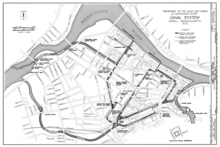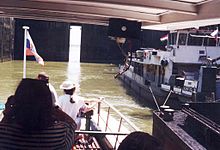A power canal is a canal used for hydraulic power generation, rather than for transport of watercraft. The power canal was a major factor in the Industrial revolution in New England in the 19th century. Most early power canals were mill races used mechanically to transfer power directly from falling water to machinery in mill buildings. Later, the hydraulic power generated electricity locally for the same mill factories. These power canals were often filled in as electricity (transported by power lines) replaced the need for local water power, and road transport needs or city expansion needs reclaimed the land. Some hydraulic power canals were transformed into local electric generators, but most were closed. Remains of power canals can be seen in old mill towns and are often protected as historical structures today.



United States edit
California edit
- California Powder Works (1864-1914)[1]
Maine edit
- Cumberland and Oxford Canal (1871-1905) was originally a transport canal from 1832[2]
Massachusetts edit
- Holyoke Canal System (1827)
- Merrimack Canal (1820s)
- Lowell Power Canal System and Pawtucket Gatehouse (1821)
- Turners Falls Canal (1869) was originally a transport canal from 1798
Michigan edit
New Hampshire edit
- Nashua power canal (1826), part of Mine Falls Park
- Amoskeag Falls power canal originally dug for transport in 1807
New York edit
Ohio edit
Notes edit
- ^ "The California Powder Works Flume". Santa Cruz Public Libraries. Retrieved 2013-05-02.
- ^ "Historic Interpretive Signs about the Oriental Powder Mills Installed" (PDF). Presumpscot Regional Land Trust. Archived from the original (PDF) on 2011-07-27. Retrieved 2010-07-30.
- ^ Sullebarger Associates, PAST Architects. "Ahimaaz King House and Carriage House Historic Structure Report" (PDF). Deerfield Township, Ohio. Archived from the original (PDF) on 2 June 2012. Retrieved 29 November 2014.